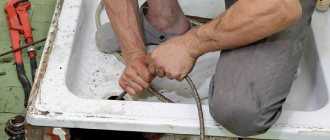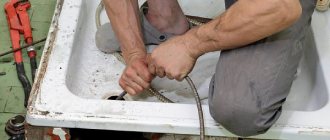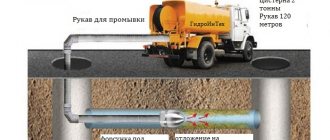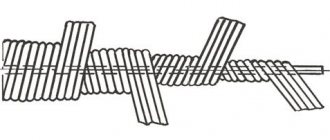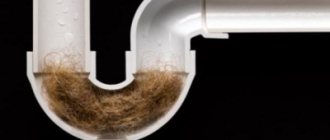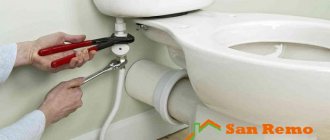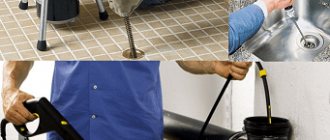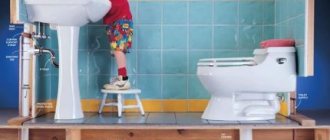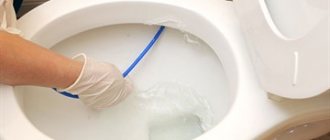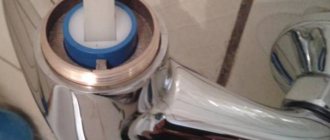The sewerage system of a private house, unlike city apartments in multi-storey buildings, has a significant length - this imposes certain requirements for its installation to ensure uninterrupted operation. Due to the large length of the sewer line and its location outside underground, the likelihood of blockages increases and owners, in order to save money, often have to decide on their own how to clean the sewer pipes in a private house.
Since in this case we are not talking about calling specialists with special equipment, we are considering inexpensive budget funds and devices for cleaning sewer pipes offered in the retail chain. The choice of cleaning method largely depends on the purpose and material of the sewer line, the nature of the blockage, the length and location of the pipeline line.
Autonomous sewerage - diagram
What are the causes of blockages?
Before clearing blockages in the sewer system, it is necessary to determine the cause of their occurrence. Moreover, there are places where they form most often, for example in the sink or in the place where the sewer pipe from the bath and kitchen goes into a common riser. And given the ability of cast iron pipes to silt up the inner diameter, the likelihood of blockage in this area is very high. The siphon in the sink often becomes dirty due to food residues draining into it. Another common problem is the presence of grease on the inner walls of the pipeline.
The cause of blockage of the riser or other communication veins may depend on the pipes used; they are of two types:
- Cast iron.
- Plastic.
In the first case, cast iron tends to collect plaque and rust inside the pipe. Corrosion causes the walls to become uneven, which encourages waste collection. Often, when dismantling them with a diameter of 110 mm, the passage was about the size of a little finger (2–3 cm).
Plastic piping is prone to clogging. In most cases, it is necessary to clean the sewer from grease due to improper installation of the route (failure to comply with the angle of inclination). A plaque appears that gradually fills the entire internal diameter of the pipe.
What is the cable for?
The cable cleans risers, drains, toilets and other plumbing fixtures, eliminating the following blockages:
- operational (deposits and growths formed by accumulations of fat, hair, small debris, food particles), easily dealt with;
- mechanical (dense solid objects that have fallen into the sewer due to careless use), if a large object is stuck, you will need to disassemble the riser;
- technological (accumulation of sand and small debris as a result of improper installation of the system), helps temporarily, because If the pipe angles and other imperfections are not corrected, blockages will appear periodically.
To punch the plug, 1 end of the cable is rolled into a ring and held in the hand, and the second is lowered into the pipe as deep as possible, rotating it for better advancement.
You can rotate the device in any direction, it is important not to change direction during operation. Periodically it must be removed and freed from debris. When the water starts to drain, you need to remove the cable, pump the pipe with a plunger and pour a bucket of water, preferably hot.
Types of blockages
There are three varieties: Operational. A blockage forms in the sewer pipe as it is used and eventually forms deposits on the walls of various formations. Gradually they reduce the diameter of the pipe. Restoration requires thorough rinsing.
Mechanical . The problem appears when a large object, rag, etc. gets into the pipeline. To eliminate it, you must completely remove the item.
Technical . Appears due to damage to the pipeline. Explained by the presence of a counter-angle, insufficient slope or a large number of turns. This type of congestion depends on non-compliance with installation technology.
How and with what to determine the location of the blockage?
If the sewer is clogged, you must first determine the intended location. In a private house, we will conditionally divide the entire system into two zones: the house and the street.
In the house you should pay attention to the following places:
- In the siphon under the sink in the kitchen and bathroom.
- In a corrugated pipe under the washbasin.
- At the exit of the riser to the street.
- At the connection of smaller pipes with a larger diameter.
There may be such places on the street:
- At the outlet of the pipe in the septic tank.
- On the section between the wells.
Chemical cleaning method
Industrial household chemicals are used for preventive purposes and are suitable for removing mild to moderate blockages. Manufacturers offer drugs in the form of powder, granules, gel, and liquid. Their action is based on the active destruction of the garbage plug as a result of the interaction of chemicals. When choosing a drug, you should pay attention to what type of pipes it is suitable for. Some chemicals can adversely affect metal and plastic walls. Cleaning the riser should be carried out strictly in accordance with the manufacturer's instructions.
Types of cleaning at home
There are many ways to clean a drain:
- Mechanical.
- Electromechanical.
- Chemical.
- Hydrodynamic.
- Thermal.
- Pressure.
Let's consider all the features of these methods for clearing sewers when removing blockages.
Mechanical
Mechanical is carried out with a cable for punching and cleaning the sewer. There are several types of it:
- Cable.
- Tape.
- Spring-loaded.
- Spring with rod.
Cable. A standard size sewer cable has a cross-section of Ø6 mm. Made from galvanized steel. It is strong, durable, elastic, flexible. The end of the cable is specially crimped so that it does not unwind. It looks like a brush and you can wrap hair dirt around it. It is best to clean it at home when its length is up to five meters.
Tape . Flat cable for cleaning sewer pipes. The width of the tape reaches up to 40 mm. Because of this specific shape, it is difficult for them to go through a large number of turns (due to the ability to bend only in one plane).
Taking this feature into account, ribbon plumbing cable is used for punching pipes of large diameter and length, since it will definitely not twist along its course.
Spring with rod. It is used by professionals.
Mechanical cleaning of the home sewer with a spring cable allows you to remove complex and large blockages. It is based on wire and spring.
A galvanized cable located inside the spring is used as a rod.
The cable diameter ranges from 13 to 16 mm. As for the length, it reaches up to 60 m.
Spring-loaded . The cable consists of one spring.
It's hollow inside. Diameter no less than 9 mm. The cable must be equipped with a handle for its rotation. It is used for pipes of small diameter, as well as for minor blockages.
How to break through a sewer yourself with a cable?
One end of the cable should be directed into the pipe and gradually pushed through. At the same time, you need to turn the handle.
Due to this, the cable will sink further and, thanks to rotation, break up the clogged area.
Advice! Cleaning a sewer in a private home with this equipment should only be performed by two people. One turns, and the second pushes the cable in the desired direction.
To achieve the best results, this equipment is equipped with additional attachments. Their use allows you to quickly remove debris accumulation. Nozzles:
- Hook.
- Harpoon.
- Pike.
- Ruff.
- Pear-shaped drill.
- Shovel-arrow.
- Cone drill and others.
Electromechanical
Clearing the blockage can be done using electromechanical equipment. The essence of the technology is a rotating steel wire. To achieve a better result, various attachments are put on its end:
- Drilling.
- Scraper.
- Pear-shaped.
- Hook-shaped.
The choice is made based on the goal or the nature of the problem. They can crush dirt. The spiral rotates thanks to an electric motor, and this special equipment has a gearbox that feeds the wire. Cleaning large sewer networks using this method allows achieving better results, since the length can exceed 100 meters with a pipe diameter of up to 600 mm.
TOP 3 products that will help if you are unable to clear the blockage with a plunger
Liquid cleaners are easy to purchase at any hardware store or supermarket, and they are affordable for almost any budget.
In terms of effectiveness, the compositions of decongestants are almost equal, and sometimes even better, than mechanical cleaning.
- Mole.
Known on the market for more than ten years. Recently, with the same composition, along with the liquid product, they began to produce powder and gel. “Mole” is based on inorganic alkali and various additives that enhance the effect. - Tiret turbo pipe cleaner.
Available in the form of a thick gel. Due to its consistency, it penetrates deep into the cork and dissolves even the most complex blockages. Manufacturers also added antibacterial action and aromatic fragrances. Ideal for plastic or metal pipes. - Deboucher.
That rare case when it is better than in advertising - according to the instructions, the product copes with blockages in an hour, but in fact the problem goes away earlier. Of course, this effect is achieved by a chemical composition, so it is important to follow safety precautions when working with such a potent product. They are usually indicated by the manufacturer on the packaging or insert; if the text is not readable, you can find information on the Internet. In any case, you should remember the general safety precautions:
- protect your hands with rubber gloves (if you don’t have them on hand, you can wear regular plastic bags);
- Wear a mask to protect yourself from inhaling chemicals.
How to clear a clog with a cable: step-by-step algorithm
More details
How to clean and rinse the siphon?
A clogged siphon is considered a simple task, and even a schoolchild can get rid of it on his own.
Advice! The easiest way is to disassemble the siphon. If this is not possible or there is simply no desire to get your hands dirty, then chemical and mechanical methods are used.
Can be used for a siphon - plunger. Sharp up/down movements can push through the dirt. If it is not there, then clean the drain with vinegar and soda.
Vinegar and soda
Cleaning drains with vinegar and soda is performed in the following sequence:
- Pour a small amount of dry soda (half a pack) into the siphon through the drain hole.
- It is important that the soda does not get stuck through the protective grille. To do this, you can push it with a stick or build a funnel out of paper.
- Then pour in half a liter of vinegar.
- A hissing reaction will then occur.
- As soon as the reaction stops, pour out the boiling water.
If the result is not achieved, the procedure can be repeated.
Advice! Before you clean the sewer pipe and siphon with soda and vinegar, you need to make sure that the problem is in this place.
Lemon acid
First, citric acid is poured into the siphon hole, and then water, or preferably vinegar, is poured in. The hissing process will remove dirt very quickly.
Using a plunger for sewerage
You can use a plunger to clean drain pipes in a bathroom, toilet or sink. This is a very effective tool that operates on a dual principle. It creates pressure, which allows the resulting plug to move, and destroys it. As a result, they are easily removed from the sewer under a stream of water.
The plunger should be used using the following technology:
Cleaning drains with a plunger
- If there is a plug intended for filtering wastewater, it should be removed.
- It is necessary to plug the overflow hole in any way.
- The plunger is lubricated with Vaseline or grease, which will improve its adhesion to the surface of the sink.
- The sink or bathtub is filled with water so that when using the plunger, its bowl is completely covered with liquid.
- The tool is placed over the drain hole and pressed tightly. The plunger is made 15 sharp movements up and down, after which it is torn off. At the same time, you need to make sure that water does not flow under the bowl, which will reduce the effectiveness of the procedure.
- If necessary, all manipulations are repeated again until the blockage is completely removed.
Preventing blockages
It's better to prevent the problem from happening than to figure out how to clear your sewer pipes of contaminants. Therefore, experts recommend carrying out preventive work:
- Once a month pour boiling water. Just don't pour it down the toilet, it will crack.
- Clean siphons once a month using soda and vinegar or disassemble them.
- When washing dishes, use warm water and detergents.
- Pump out wastewater from the septic tank in a timely manner.
- Use chemicals for prevention.
